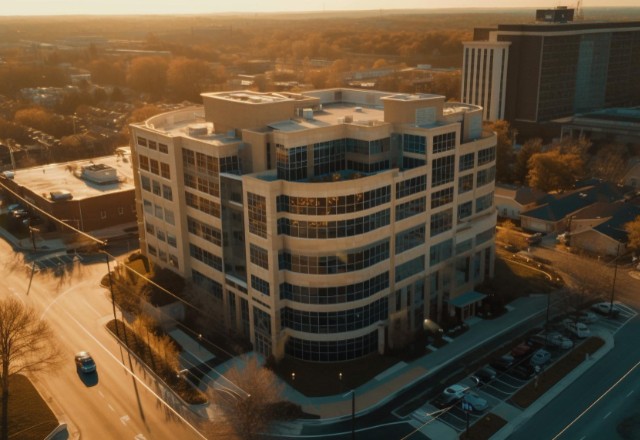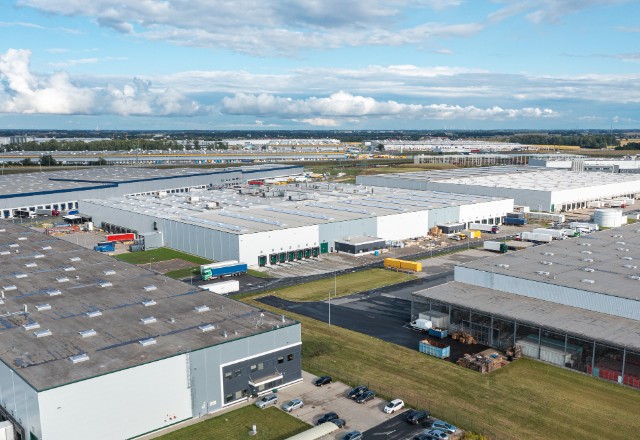If you’ve ever taken a stroll through a commercial district or an industrial park, you might have noticed that many larger buildings feature flat roofs. This observation often leads people to wonder, “Why are flat roofs common on larger commercial buildings?” In this comprehensive article, we’ll explore the various reasons behind this architectural trend and delve into the advantages and considerations associated with flat roofs on commercial structures.
What is a Flat Roof?
Before we dive into the reasons why flat roofs are common on larger commercial buildings, let’s first define what a flat roof is. Contrary to its name, a flat roof is not entirely flat. It typically has a slight slope, usually around 1/4 inch per foot, to allow for proper drainage. This subtle incline ensures that water doesn’t pool on the roof’s surface, which could lead to leaks and damage over time.
Advantages of Flat Roofs for Commercial Buildings
There are several key advantages that make flat roofs a popular choice for larger commercial buildings. Let’s explore these benefits in detail:
Cost-Effectiveness
One of the primary reasons why flat roofs are common on larger commercial buildings is their cost-effectiveness. Flat roofs generally require fewer materials and less labor to install compared to pitched roofs. The simplified design and construction process can lead to significant cost savings, especially for larger commercial projects where every dollar counts.
Moreover, the reduced material requirements also contribute to lower maintenance and repair costs over the life span of the roof. When issues arise, flat roofs are typically easier and less expensive to repair compared to their pitched counterparts.
Ease of Maintenance and Repair
Another factor contributing to the prevalence of flat roofs on commercial buildings is the ease of maintenance and repair. The flat surface allows for safer and more convenient access for inspections, cleaning, and repairs. This accessibility is particularly important for larger commercial buildings, where regular maintenance is crucial to ensure the longevity and performance of the roofing system.
Flat roofs also make it easier to identify and address potential issues before they escalate into major problems. Leaks and damage can be more readily detected and repaired on a flat surface, minimizing disruptions to building operations and preventing costly water damage to the interior.
Space Efficiency
Flat roofs offer unparalleled space efficiency, which is a significant advantage for larger commercial buildings. By eliminating the need for a pitched roof, flat roofs allow for the maximization of interior space. This is particularly valuable in urban areas where land is scarce and building footprints are limited.
Furthermore, flat roofs provide an opportunity to utilize the rooftop space for various purposes. Many commercial buildings leverage their flat roofs to house HVAC units, solar panels, satellite dishes, and other mechanical equipment. Some even transform their rooftops into amenity spaces, such as rooftop gardens, patios, or recreational areas.
Energy Efficiency
Flat roofs can also contribute to the energy efficiency of commercial buildings. The flat surface is ideal for the installation of green roofing systems, which involve covering the roof with vegetation. Green roofs offer numerous benefits, including improved insulation, reduced urban heat island effect, and better stormwater management.
In addition, flat roofs are well-suited for the installation of solar panels. The unobstructed, flat surface allows for optimal positioning and orientation of the panels to maximize energy production. By harnessing solar energy, commercial buildings can reduce their reliance on traditional energy sources and lower their energy bills.

Common Flat Roofing Materials for Commercial Buildings
There are several common materials used for flat roofs on commercial buildings, each with its own advantages and characteristics. Here are some of the most popular options:
Material | Description | Lifespan |
Built-up Roofing (BUR) | Multiple layers of bitumen and reinforcing fabric | 20-30 years |
Modified Bitumen | Asphalt-based sheets with polymer additives | 20-30 years |
TPO (Thermoplastic Polyolefin) | Single-ply membrane with heat-welded seams | 20-30 years |
PVC (Polyvinyl Chloride) | Single-ply membrane with heat-welded seams | 20-30 years |
EPDM (Ethylene Propylene Diene Monomer) | Single-ply rubber membrane | 20-30 years |
The choice of roofing material depends on various factors, such as climate, building usage, budget, and desired longevity. It’s essential to consult with a professional roofing contractor to determine the best material for your specific commercial building.

Factors to Consider When Choosing a Flat Roof
While flat roofs offer numerous benefits for commercial buildings, there are several factors to consider when choosing this roofing system:
Climate and Weather Conditions
The local climate and weather patterns play a crucial role in determining the suitability of a flat roof. In areas prone to heavy rainfall or snowfall, proper drainage and waterproofing are essential to prevent ponding water and leaks. Regions with extreme temperatures may require specific roofing materials that can withstand the heat and cold.
Building Size and Structure
The size and structural characteristics of the commercial building must be taken into account when selecting a flat roof. Larger buildings may require additional support or specialized designs to accommodate the weight and stress of the roofing system. The building’s intended use and occupancy also influence the choice of roofing material and design.
Local Building Codes and Regulations
It’s crucial to ensure that the flat roof complies with local building codes and regulations. These codes may specify requirements for drainage, insulation, fire resistance, and other safety aspects. Working with a knowledgeable roofing contractor familiar with local regulations can help ensure compliance and avoid potential issues down the line.
Maintenance and Repair of Flat Roofs
To ensure the longevity and performance of a flat roof, regular maintenance and prompt repairs are essential. Here are some key aspects of flat roof maintenance:
Regular Inspections
Scheduling regular inspections, at least twice a year, can help identify potential issues early on. A professional roofing contractor can assess the condition of the roof, check for any signs of damage or wear, and recommend necessary repairs or maintenance tasks.
Debris Removal and Cleaning
Flat roofs are prone to accumulating debris, such as leaves, branches, and dirt. Regular cleaning and removal of debris are crucial to prevent clogging of drains and gutters, which can lead to ponding water and leaks. It’s also important to keep the roof free of any vegetation growth, as roots can penetrate and damage the roofing material.
Prompt Repair of Damage
If any damage or leaks are detected during inspections or routine maintenance, it’s essential to address them promptly. Ignoring even small issues can lead to more extensive and costly damage down the line. A professional roofing contractor can assess the extent of the damage and recommend the appropriate repair solutions.

Potential Drawbacks of Flat Roofs
While flat roofs offer numerous advantages for commercial buildings, there are also some potential drawbacks to consider:
Drainage Issues and Ponding Water
One of the main challenges with flat roofs is ensuring proper drainage. If the roof doesn’t have an adequate slope or if the drainage system is compromised, water can accumulate on the surface, leading to ponding. Ponding water can put extra stress on the roofing material, increase the risk of leaks, and promote the growth of algae and vegetation.
To mitigate this issue, it’s crucial to have a well-designed drainage system, including sufficient roof drains, scuppers, and gutters. Regular maintenance to keep the drainage system clear and functional is also essential.
Higher Risk of Leaks
Flat roofs are more susceptible to leaks compared to pitched roofs. The lack of a steep slope means that water doesn’t shed as easily, and any imperfections or damage to the roofing material can allow water to seep through. Leaks can cause significant damage to the building’s interior, including the walls, ceilings, and insulation.
To minimize the risk of leaks, it’s important to choose a high-quality roofing material, ensure proper installation, and maintain the roof regularly. Prompt repairs of any damage or deterioration can also help prevent leaks from occurring.
Shorter Lifespan
In general, flat roofs have a shorter lifespan compared to some pitched roof materials, such as metal or tile. The constant exposure to the elements, UV radiation, and the potential for ponding water can accelerate the deterioration of the roofing material.
However, with proper maintenance and timely repairs, a well-constructed flat roof can still provide a serviceable life of 20-30 years or more, depending on the material used.
Innovations in Flat Roofing
In recent years, there have been several innovations in flat roofing technology that address some of the challenges and enhance the benefits of this roofing system:
Green Roofs
Green roofs, also known as living roofs, involve installing a layer of vegetation on top of the flat roof. This eco-friendly option offers numerous benefits, including improved insulation, reduced urban heat island effect, better stormwater management, and enhanced biodiversity.
Cool Roofing Materials
Cool roofing materials are designed to reflect sunlight and emit heat more efficiently, reducing the amount of heat absorbed by the building. These materials can help lower cooling costs, improve indoor comfort, and extend the lifespan of the roof by reducing thermal stress.
Solar Panel Integration
Flat roofs provide an ideal platform for the installation of solar panels. By integrating solar technology, commercial buildings can generate renewable energy, reduce their carbon footprint, and lower their energy bills. The flat surface allows for optimal positioning and orientation of the panels to maximize energy production.

Real-World Examples
To illustrate the prevalence and benefits of flat roofs on commercial buildings, let’s look at some real-world examples:
- Walmart Supercenter – Many Walmart Supercenters feature flat roofs, which allow for the installation of rooftop HVAC units and solar panels. The flat roof design also maximizes interior space and reduces construction costs.
- FedEx Distribution Centers – FedEx distribution centers often utilize flat roofs to accommodate the large, open interior spaces required for sorting and storing packages. The flat roof also allows for easy installation and maintenance of rooftop mechanical equipment.
- Urban Office Buildings – In cities where land is at a premium, many office buildings opt for flat roofs to maximize usable space. These roofs often feature rooftop gardens or amenity spaces, providing a valuable outdoor retreat for employees.
- Hospitals and Healthcare Facilities – Flat roofs are a common choice for hospitals and healthcare facilities due to their cost-effectiveness, ease of maintenance, and the ability to house essential mechanical equipment, such as HVAC systems and backup generators.
Conclusion
In conclusion, flat roofs are common on larger commercial buildings for various reasons, including cost-effectiveness, ease of maintenance, space efficiency, and energy efficiency. Understanding why flat roofs are prevalent on commercial structures helps building owners, managers, and designers make informed decisions about their roofing systems.
When considering a flat roof for a commercial building, it’s essential to factor in the local climate, building size and structure, and local building codes. Choosing the right roofing material, ensuring proper installation, and implementing a regular maintenance schedule are crucial for maximizing the benefits and longevity of the flat roof.
As innovations in flat roofing technology continue to emerge, such as green roofs, cool roofing materials, and solar panel integration, the advantages of flat roofs for commercial buildings are likely to grow. By embracing these advancements and working with experienced roofing professionals, commercial building owners can leverage the full potential of their flat roofs, creating more sustainable, efficient, and functional structures.



 509-201-4190
509-201-4190
